#permaculture design course
Explore tagged Tumblr posts
Text
Typical Content and Structure of Permaculture Courses Near Me
Permaculture, a portmanteau of permaculture courses australia is a holistic approach to sustainable living and land use design. Permaculture courses offer individuals the knowledge and skills needed to create regenerative and self-sufficient ecosystems. If you're considering enrolling in a permaculture course near you, this article will provide an in-depth understanding of the typical content and structure you can expect. By the end, you'll have a clearer picture of what to anticipate and how these courses can empower you to make a positive impact on the environment and your community.

Understanding the Basics
Introduction to Permaculture
The journey begins with a foundational introduction to permaculture. In this module, you'll learn about the history, ethics, and principles that underpin permaculture design. It sets the stage for a deep dive into sustainable practices and systems thinking.
Ethics and Principles
Permaculture is guided by three core ethics—Earth Care, People Care, and Fair Share. You'll explore these ethical principles in-depth, along with the twelve design principles that serve as a roadmap for sustainable living and land management.
Designing with Nature
Observation and Site Analysis
One of the fundamental skills in permaculture is keen observation. You'll learn how to assess a site, analyze its unique characteristics, and identify opportunities for regenerative design. This phase involves mapping, soil analysis, and understanding microclimates.
Design Techniques
This module delves into various design techniques used in permaculture, such as zoning, sector analysis, and the use of patterns in nature. You'll discover how to apply these techniques to create functional and productive spaces.
Sustainable Agriculture
Organic Gardening
A key aspect of permaculture is growing food sustainably. You'll gain practical knowledge of organic gardening, including soil improvement, crop rotation, companion planting, and pest control techniques.

Food Forests and Agroforestry
Permaculture encourages the creation of food forests—diverse, layered ecosystems that mimic natural forests. You'll explore the concept of agroforestry and learn how to establish and maintain food forests that yield a variety of fruits, nuts, and other edibles.
Water Management
Rainwater Harvesting and Greywater Systems
Water is a precious resource, and permaculture focuses on its responsible management. This module covers rainwater harvesting techniques and the recycling of greywater for irrigation.
Swales and Earthworks
You'll discover the art of earthworks and swale construction to capture, store, and distribute water across your landscape. These techniques help prevent soil erosion and drought-proof your land.
Renewable Energy and Appropriate Technology
Energy Efficiency
Learn how to make your home and systems more energy-efficient through passive solar design, insulation, and renewable energy sources like solar panels and wind turbines.
Appropriate Technology
Explore the integration of sustainable technology into permaculture systems, from composting toilets to small-scale wind and water power.

Community and Social Aspects
Building Resilient Communities
Permaculture isn't just about land design; it's also about building strong, interconnected communities. This module delves into the social aspects of permaculture, focusing on collaboration, communication, and resilience.
Economic Systems
Discover alternative economic models that align with permaculture principles, such as local currencies, cooperative ventures, and sustainable business practices.
Hands-On Experience
Practical Projects and Workshops
Most permaculture courses near me will incorporate hands-on projects and workshops. These provide valuable experience in applying permaculture principles to real-life situations, fostering a deeper understanding of the concepts covered in the classroom.
Permaculture Design Certification
After completing the course, you'll typically have the opportunity to obtain a Permaculture Design Certificate (PDC). This internationally recognized certification signifies your competence in permaculture design and qualifies you to work on your projects or collaborate with others in the permaculture community.

Conclusion
Permaculture courses near you offer a rich and diverse curriculum that equips you with the knowledge and skills to create sustainable and resilient ecosystems. Whether you're interested in regenerative agriculture, sustainable living, or simply want to make a positive impact on your local environment, these courses provide the tools and guidance you need. Embracing permaculture principles can lead to more self-sufficient, connected, and ecologically conscious communities, and taking that first step through a local course is a great way to start your permaculture journey.
#permaculture courses australia#online permaculture course australia#free online permaculture design course
0 notes
Text
"Natural Abundance - Sustainable Agriculture and Permaculture Course in NSW"
The best permaculture courses nsw team in Australia is led by the locals at Noosa Forest Retreat. In order to manage land and plan communities, permaculture models its designs after those of healthy natural ecosystems. It includes several design principles that were determined by applying whole systems thinking. It applies these concepts to resilient communities, regenerative agriculture, and urban planning, among other fields. At Noosa Forest Retreat, they developed acclaimed permaculture courses in NSW to educate and assist Australians with sustainable design. When you hear the phrase "permaculture courses NSW," your thoughts should focus solely on one group. The permaculture specialists at the Noosa Forest Retreats. They go above and beyond to ensure that their permaculture online courses in Australia are correctly constructed and precisely delivered in order to ensure that you get the most out of your new certification. Get in touch with us right now to have a conversation with a gorgeous employee and discover more about who they are and what they do.
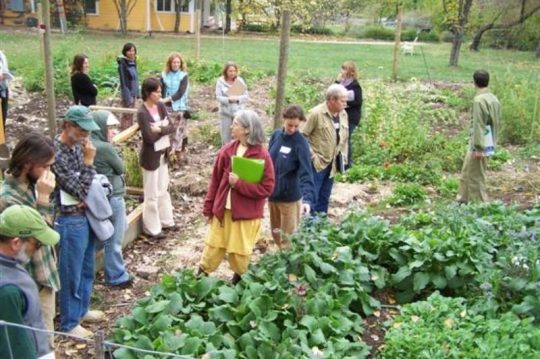
The Noosa Forest Retreats' Permaculture Design Course (PDC) is a thorough course that covers the fundamental ideas and methods of permaculture design. The course is normally taught over the course of two weeks by qualified permaculture instructors. Based on the widely acclaimed curriculum created by Bill Mollison, one of the pioneers of permaculture, Noosa Forest Retreats' PDC is provided. The course addresses a broad range of subjects, such as permaculture ethics and principles, site evaluation and design, soil science, water management, organic farming, animal husbandry, renewable energy systems, and community development. No prior experience is necessary, and the training is open to participants of all ages and backgrounds. The course includes a combination of classroom instruction, practical exercises, and field trips to permaculture sites. It covers a wide range of topics, including the ethics and principles of permaculture, site assessment and design, soil science, water management, organic gardening, animal husbandry, renewable energy systems, and community development.

#permaculture certificate course victoria#pdc permaculture design course#permaculture courses brisbane#permaculture course near me
1 note
·
View note
Text
ok so instead of going on my usual the earth is doomed spiral I started looking into solar punk solutions and stumbled across the practice of permaculture & found a free 50 video series from the university of oregon on it if anyone else would like to learn abt ways we can actually start restoring earths whole deal
3K notes
·
View notes
Text
The Permaculture Spiral Garden - A Great Starting Point
There is probably no other structure as popular for illustrating Permaculture in practice as the Herb Spiral. Okay, I guess I could mention the lasagna sheetmulching method or also the cob oven that tends to be the first hands-on project at a typical Permie intro session. But when it comes to showing how landscape design, zones and sectors, stacking functions, and efficient use of space and water come together in one unique structure, the Spiral Garden is unbeatable.
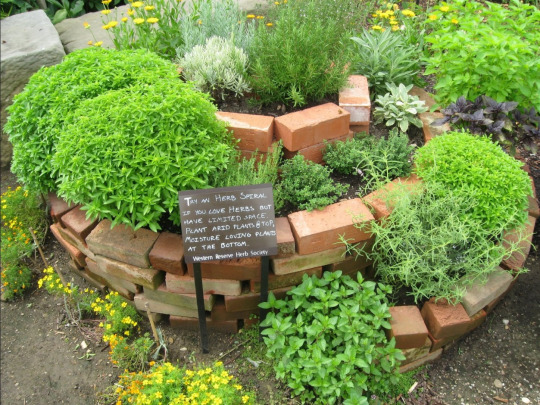
Turning Theory into Practice
In typical Permaculture Designer Certificate courses, but even in brief intro weekends to Permaculture, there tends to be a lot of theoretical discussions. Since the numerous design principles can be applied to any climatic region, from the tropical to the subarctic, and on any scale from the humongous to the tiny, the practical aspects of the ideas can easily get lost. That's where a good hands-on application comes, where the participants get to move around rocks and dirt, while realizing how much it ties in to the concepts they've just discussed. This way the apparent "main purpose" of "building something to grow all your kitchen herbs on", becomes a neat side feature.
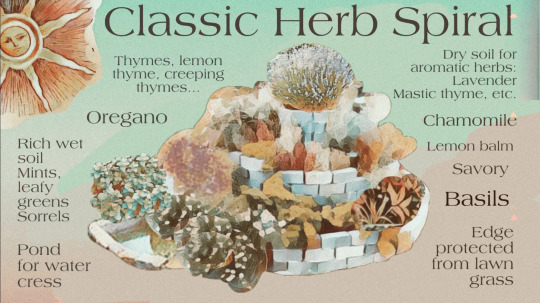
Adjust Your Landscape!
The first thing to realize that landscape is welcome to be modified and adjusted to bring out the best in it. Clearly, while it is important to work with what's there already, it doesn't hurt think about mounds and valleys. And before you bring out the excavators for your large-scale farm, it makes sense to start small… say on a circle of 2-5 meters (6-16 feet) diameter. In other words, the Spiral Garden is a hill with a spiral shaped surface, leading down to ground level, or further down into a water hole. It can be made out of rocks, bricks, concrete debris, or anything else you have lying around that can hold your soil.
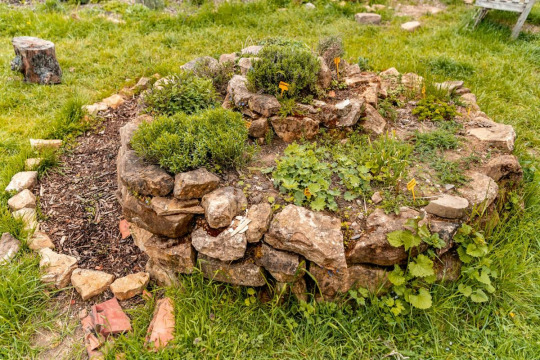
Design According to Your Scale
Looking around for existing Herb Spirals it's easy to get confused. Some are so big you can actually climb on them (that is, you have to in order to reach what's growing on top). Others are so tiny that you may not even want to step on them. The question is: which size is the right one for you? Since this is something you will have to decide almost daily in Permaculture, it doesn't hurt starting out with this important question.
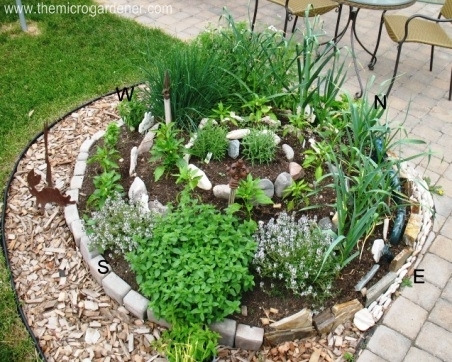
Organizing Your Spiral Garden
While there are seemingly endless types of Spiral Gardens, there are a few things they all have in common: They all start out with a region on the top, where water is bound to run off right away, leaving the soil relatively dry. This area is also the most exposed to the wind. Keep this in mind when choosing the plants that are going to live here. Ideally, the spiral should start sloping toward the East from here. Delicate plants that benefit greatly from the morning sun will appreciate this region. As the slope continues toward the South and West, it becomes more suitable for sun loving species. Finally, as the spiral reaches the ground level in the shady Northern part, it will be perfect for herbs that prefer less sun, more shade and more water, since the soil tends to be wetter here. (Note: This is for the Northern Hemisphere. In the Southern Hemisphere North and South are reversed.) To make full use of the runoff water, many people add a small pond at the base of the spiral, where additional aquatic plants, such as watercress, can be grown.
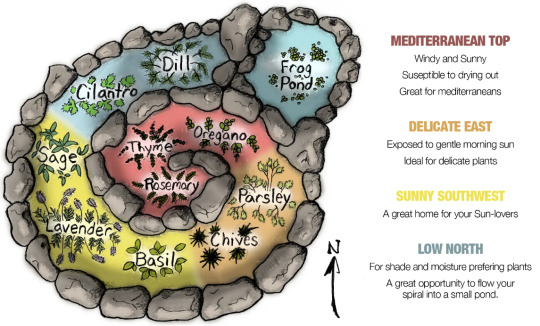
The given illustration offers a good number of herbs for a nicely diverse kitchen. Depending on what else you want in your Herb Spiral, you can add it in the most suitable region. Mint and lemon balm love the cooler, shady part with more water. Lemongrass is great in the sunny area, and tarragon and estragon prefer the dry top of the spiral. Of course, the idea is not limited to kitchen herbs. For maximalists, the same theory can work with a mountain you might want to terraform into a spiral farm. But right now I'd prefer to stay small scale.
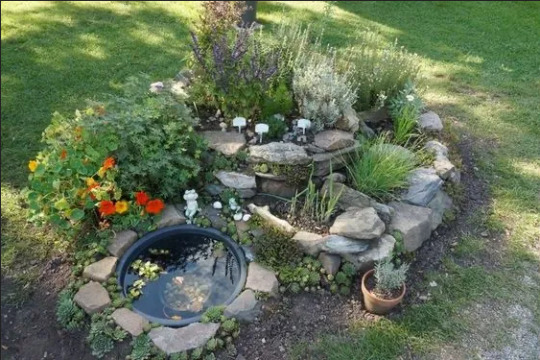
Plenty of Benefits (That's Why It's Permaculture)
As explained above, the main purpose of the Spiral Garden is not only to increase your gardening area by making use of the vertical, but also to create diverse climatic conditions, which do make a difference on the smallest scale. But as Permaculture tends to be, there are many other benefits to it. The structure itself offers great habitat for numerous animals, such as frogs, salamanders, lizards, but also pollinating insects, and of course others that may not directly benefit us, but by feeding on others they all add to the stability of our ecosystem. The structure itself will suppress weeds and make use of material that you're not likely to use elsewhere. Finally, depending on the size and location, it will be an ideal place to grow all your kitchen herbs right where you can access them most easily.
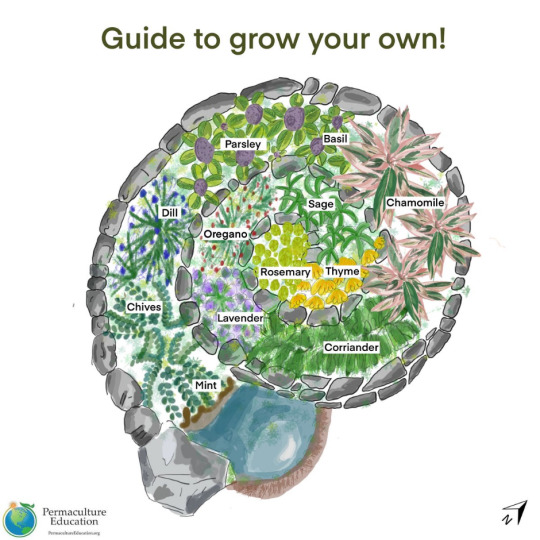
Some Things to Keep in Mind
When building the structure, make sure it will contain the soil in a nice trough, slanting slightly inward. That way bits and pieces that fall off will roll towards the center, until contained by the main mound.
Make sure the slope is always nice and gradual, avoiding sudden drops where the water can rush down quickly, eroding the soil.
If you're going to walk on your spiral, include a separate walkway that won't compress good soil. Most importantly, it should be sturdy enough to provide stability and make access safe.
Don't forget that while the structure is important to keep the soil in place, it is the soil that you'll be growing plants in. So it should have a good depth of 20-50 cm (8-20 inches) throughout the entire spiral. This can be the trickiest part!
Apply your own observation to which plants do better in which parts of the spiral. Also, with time you will find many other plants growing in it that you didn't plant. Before removing them, consider how much they actually bother your herbs, and whether their benefits may not outweigh their drawbacks.
Go Out and Build Your Own!
I hope this brief overview got you inspired to go out and try building an Herb Spiral yourself! I would love to hear your experiences with it!
Sources: 1, 2, 3, 4
3K notes
·
View notes
Text
I saw this post and thought aw man I wish my seeds were here, and literally less than five minutes later
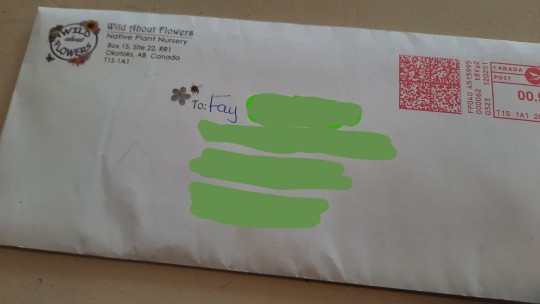
Post that makes your seeds arrive
SEEDS MY SEEDS ARE HERE
SEEDS SEEDS SEEDS SEEDS
#easy grow#native pollinator wildflower#im so excited about these seeds#they're a starter mix of seeds that dont need to stratify over the whole winter and can be planted any time in spring#and at least some of them are resistant to our hyper-local unique weather phenomena that keeps killing my#seed mixes#god its wild how specific my environment is#i took a permaculture food forestry course from some people who design food forests in a city two hours away#and so much of their advice was irrelevant to me#because their weather systems are so different#ecology
493 notes
·
View notes
Text
youtube
Permaculture instructor Andrew Millison walks around his neighborhood pointing out 7 ways that you can get started with the Front Yard Farming revolution..
Oregon State University Online Permaculture Design Course:
https://workspace.oreg...
Andrew Millison’s links:
https://www.andrewmill...
https://permaculturede...
#Andrew Millison#solarpunk#permaculture#kill your lawn#food not lawns#growing food#growing plants#anti lawn#front yard#front yard farming#garden#gardening#Youtube
15 notes
·
View notes
Text
Earth Activist Training
EAT is a permaculture design course run by Starhawk (and a rotating cast of accomplished permaculturists). It's immersive, comprehensive, and beautiful.
Not very many PDCs talk about how permaculture principles can be applied to social movements. And so few retreats have truly nourishing and excellent food. Here's the website; there are a number of educational offerings beyond the main in-person PDC. I encourage you to give it a look if you want to learn more about this amazing field we call permaculture.
https://earthactivisttraining.org/
#permaculture#starhawk#witches#Earth based withcraft#paganism#reclaiming#environment#community organizing#social permaculture#activism#activists#gardening#agriculture#aquaculture#witchblr#magic#witchcraft#ritual
15 notes
·
View notes
Text
Today (on three hours of sleep which is my own fault) my partner and I got up early and got breakfast and then went to a community education seminar at a local university's educational garden about native bees, and made a wooden bee house. Our landscape designer team (two women who I'm pretty sure are queer) was there attending and it was run by a really cool woman who runs another landscaping co-op (with a nonprofit educational side) who is also working with them to teach them all the ins and outs of permaculture, and they kinda group-projected our yard, so I got to know all three of them over the course of the contract, which was cool.
It was great, you guys. We talked about the importance of supporting native pollinators, because honeybees are fine and all but outcompete native bees, some of whom are so specialized that their exact wing frequency is what it takes to pollinate a single, specific species. The world's smallest bee is 2mm at the largest and lives right here. We've got sweat bees that look like tiny flying gems. We've got bumblebees that are so docile you can gently pet them while they're gathering pollen. We have huge, harmless carpenter bees with metallic black shiny females and golden fuzzy males and they'll bonk into you just to see what you're doing.
I got to get excited about iNaturalist to a bunch of people who haven't heard about it before! I got to see thousands of honey bees just doing their business and I realized I wasn't having my usual phobic reaction anymore! I got to use a power drill! I got on the mailing list and I'm gonna see if I can't get even more involved in this kind of shit over time, because it's honestly great.
You're only one person but even little things can have an outsized impact, and it's not in turning off the water when you brush your teeth, it's in things like planting native keystone species so that the other living things that rely on it can move back in. Even in a tiny area. Animals and plants spread and have ripple effects. The same way removing a species causes a spreading collapse, bringing back a species, even just one, causes a spreading regrowth of diversity. Literally a handful of plants can support countless insects that support countless animals and this changes the environment just a little bit at a time back to a better state. It does make a difference and it doesn't have to be hard or expensive.
I get really excited about native species because as I see it, getting educated about them and making decisions to support them is what's going to locally make the biggest impact for the least money. The success stories can be literally microscopic, when it comes to things like soil microbes, but they really, really matter. One person can't fix the whole climate but one person can fix a one-person-sized patch of ground, and that's enormous when you remember that thousands of important little things spend their entire lives within even the smallest yard.
Anyway I'm tired to hell now but hey maybe next spring we'll have a bunch of big goofy carpenter bees living in the yard! Or even other native bees. I'm hype as heck to find out.
Also, and I forgot to say this so ETA, I guarantee THIS IS HAPPENING wherever you are. Look up your closest university and find out what kind of research/community gardens they have and what kind of seminars they offer. Look into your state and county conservation programs. There's outreach education all over, and a whole lot of it is donate-as-you-can, because they just want to get knowledge into the community. If you want to hear it, they want to teach it to you, and they're almost universally some of the kindest folks you're going to meet. If this sounds even a tiny bit interesting, do some searching and I would bet you anything there's opportunities right there waiting.
77 notes
·
View notes
Text
so there's a thing they talk about in permaculture (caveat: I work at a farm but am not a farmer) about how modern industrial & agricultural practices are destructive, (obviously).
And modern environmental & labor groups talk a lot about sustainability which is equally obviously better.
But if we've already destroyed a shit ton of topsoil (which we have the stats are horrifying) we don't just need to sustain what we've got. We need more of it! We need to grow! We need to look for regenerative systems!
Which, yk, is what permaculture is trying to be, but of course it's being implemented by people and people think they're smarter than they are a lot of the time, and get caught up in following the process they like rather than, you know... context and design for each new situation. (Growth for growth's sake is stock markets and cancer, which gets us back to destructive, so obviously we ALSO need to know when to just sustain rather than keep trying to spiral UP.)
...
where was I?
Idk, Thing 2 wanted to go to the library and we just got back and it's been like two hours I have no idea what I was going to talk about. Sorry y'all. Good theories are good! People are people though, so. ¯\_(ツ)_/¯
That's apparently all I've got.
...
Tangentially related, the community outreach and farming stuff I've been learning in my apprenticeship has pretty much all been interesting, and the basic office/professional culture skills it also teaches have mostly just validated that I do actually know a lot more about adulting than I thought I did.
But then I had to watch a marketing video and it's talking about identifying your customer and focusing your message so you're talking to them specifically and I'm all
that's it
market segmentation at the global level is the root of much evil, pink tax and being offended when your ACTUAL fans/customers are not the group you thought you were aiming at which has led to so many petty creators breaking all their toys out of spite and is one of the ultimate 'thinking people are things' that Granny warned us about (#gnu terry pratchett) and then I had to take a break from work shit for awhile because that wasn't going to help me write a new resume to show my apprenticeship mentor was it?
also also I had my physical this morning a millionty years ago and have like three different follow-up-things scheduled the next month, I am so tired, *sighs*
how are you today, my dears & darlings?
13 notes
·
View notes
Note
Can you share more about your degree? It sounds super interesting! Mine was just pretty straight forward (literature) lol.
sure!!
horticulture is never rlly easy to explain bc there's the basic definition of like "the art or practice of garden cultivation and management" according to the oxford dictionary (that i googled lol) but it's like. so many "hard" sciences and "soft" sciences mixed together. my first class was intro to horticulture and one of our tasks was to legit make our own definition.
i always explain it as the study of the art and science behind plants and how we apply them to our environments, human made or not.
i just have a two year degree bc i went to community college but it's skdkskd usually enough to get a job in the industry & work your way up. my degree was also very very hands on. during the 2020-2021 lockdown i had to go on campus despite the rest of it being closed (obv we were masked & stayed outside) but it was for classes like plant id courses, nursery production, etc
my fave classes were entomology (study of insects) & plant pathology (diseases caused by pathogens & environmental conditions!!). i also loved plant propagation (how to grow seeds!!!!) and it led to how i chose my certification in greenhouse production!! i learned basically how a greenhouse runs & how to manage it!! (i have a second certificate in permaculture (permanent agriculture in which you learn how to garden but it's a self sustaining ecosystem based on where u live!!) but that is based on a number of hours completed rather than taking a bunch of classes)
there is also a huge push for sustainability! lots of my professors had their docorates and masters in climate science and were very open & honest abt the way of the world & how gray it is in terms of what we make advancements in. (first class ever we talked abt gmos which are a touchy subject a lot of the time. they have their bads and goods. it's very messy as a topic & no clear answer on what to do bc they can't just get rid gmos but also? can't we do better with them?)
it's also learning abt how the industry in terms of sales & how plants grown travel. learning at shipments & the amt of mileage with a semi truck vs other forms of transport. how much each stop in the supply chain gets when you buy groceries (shopping local vs. big box stores).
i also did a project with my old high school in designing an outdoor classroom for them & learned abt designing a landscape (this was specifically one using mostly native plants!)
we would go to local forest preserves to learn about different ecosystems and biomes and why native plants are best but also how the majority of plants brought over, like, 80%, are not invasive. we did learn abt invasive plants as well and were very carefully instructed on proper control for pests (ranging from plants to insects to bacteria to virus... altho if your plant catches a virus... godspeed). chemical controls are ALWAYS a last resort.
we would go to local nurseries and greenhouses and farms to learn abt how they run!!!
it was just so much hands on learning and better understanding how the world works while also being told straight up where the world is heading (esp with climate change which will lead to inevitable zone shifting for what plants can grow where) and it's just augh!! so broad idek what to specifically go in on!! it's an amazing field!!
#i didn't even get into agricultural studies and arboriculture (trees) and landscape design & management (my least fave tbh)#we also had our own farm on campus that provided vegetables for the cafeteria during the warm seasons#and had a farmers market one day a week#we had a plant sale every year and our classes would basically be the ones that GROW THE PLANTS for the sales#literal hands on experience throughout#i am always sad i struggle with finding smth where i live now that's in my field but#i'm hopeful....#rose answers#evilwriter37#thank u for asking!!!
12 notes
·
View notes
Text
Trees and their Roles in Permaculture Designs
Trees are of course very important elements in many permaculture designs. The specific roles that they can play, however, can be many and varied, and trees must always be used in the right places, and within the right type of design, to achieve the right results. Tree planting is almost invariably talked about as a good thing. But there are different types of tree planting and not all are…
#afforestation#agroforestry#forest gardening#permaculture#permaculture design#planting trees#reforestation#tree#tree planting#trees
3 notes
·
View notes
Text
Harmony Farms: A Sustainable Haven for Community and Agriculture
A Commitment to Sustainability
At the core of Harmony Farms’ philosophy is a steadfast commitment to sustainable farming practices. The farm employs a diverse array of methods to ensure that its impact on the environment is minimal. Crop rotation, cover cropping, and integrated pest management are just a few of the techniques used to maintain soil health and reduce the need for chemical interventions. These practices not only enhance the fertility of the land but also promote biodiversity, ensuring that the farm remains a vibrant ecosystem.
Moreover, Harmony Farms is powered by renewable energy. Solar panels dot the landscape, providing clean energy to power farm operations. This investment in green technology reflects the farm's dedication to reducing its carbon footprint and modeling environmentally responsible behavior. Water conservation is another critical focus, with advanced irrigation systems and rainwater harvesting techniques ensuring that water is used efficiently and sustainably.
Community Engagement and Education
Harmony Farms is not just a place to buy fresh produce—it's a community hub. The farm hosts a variety of educational programs aimed at all age groups. From school field trips that teach children about where their food comes from to workshops for adults on sustainable gardening practices, the farm is a place of learning and discovery.
The community-supported agriculture (CSA) program is a cornerstone of Harmony Farms' community engagement efforts. By subscribing to the CSA, members receive a weekly share of the farm's bounty, ranging from crisp vegetables and fruits to fragrant herbs and flowers. This model fosters a direct connection between the farmers and the consumers, creating a sense of shared responsibility and mutual support.
Additionally, Harmony Farms organizes seasonal events and festivals that bring people together to celebrate the harvest and learn about sustainable living. These events are a great way for the community to come together, enjoy local food, and participate in hands-on activities like apple picking, pumpkin carving, and farm tours.
Innovation in Agriculture
Innovation is at the heart of Harmony Farms' operations. The farm continually experiments with new techniques and technologies to improve yield and sustainability. One such innovation is the use of permaculture principles, which focus on designing agricultural systems that mimic natural ecosystems. This approach has led to the creation of diverse, self-sustaining plant communities that require minimal intervention.
Harmony Farms also collaborates with local universities and agricultural organizations to stay at the forefront of agricultural research. These partnerships allow the farm to implement cutting-edge practices and share its findings with the broader farming community. By being a leader in sustainable agriculture, Harmony Farms hopes to inspire other farms to adopt similar practices.
A Vision for the Future
Looking ahead, Seattle Dispensaries aims to expand its impact by increasing its outreach and continuing to innovate. Plans are in place to develop an on-site farm-to-table restaurant, where visitors can enjoy meals prepared with ingredients grown right on the farm. This initiative will further strengthen the connection between the community and the source of their food.
Harmony Farms also envisions expanding its educational programs, offering more extensive courses in sustainable agriculture and food production. By doing so, the farm hopes to nurture the next generation of farmers and environmental stewards.

0 notes
Text
Australian Permaculture Courses with Leading Permaculture Educators.
Crystal Waters Eco Village near Maleny / Conondale has established its reputation as a centre for Permaculture here in Queensland with its history going back over 35 years.
The PDC Permaculture Course offering at Crystal Waters includes several Presenters with decades of experience in Permaculture, Sustainable agriculture, Soils & Seeds, Organics and Design principles. The Presenters for this PDC Course include Robin Clayfield, Max Lindegger, Annaliese Hordern & a range of other great special guest presenters.
Permaculture is a design system that attempts to emulate nature in the design and experience that we have within our living environments. Encompassing a wide range of topics on ecological living, from energy efficiency to sustainable and organic agriculture, examining our relationship with water, sun, food and soil - to living in harmony with our environment.
The idea of permaculture as ‘permanent agriculture' is evolving. In recent times there has been significant recognition of the need for more sustainable living and improving our ability to live in harmony with Nature and become more sustainable in all aspects of our lives. Many people are now seeking solutions to modern "out of balance" living and these Courses and the experience here are aimed to elevate people of any age to discover and design sustainable living strategies for their own life.
Crystal Waters has developed over 35 years ago, designed along Permaculture principles. It now houses over 250 people of all ages in 83 properties, on the 640 acres of bushland at the headwaters of the Mary River. Abounding with wildlife and birdlife, Crystal Waters is a nature sanctuary worth experiencing. The Village Green is also a place for regular social interaction with events and monthly markets.
Participants will experience Permaculture first-hand through visiting several local properties and hearing from people about their practical experiences on their land.
The Ecopark camping area provides a lovely place in Nature for visitors to stay during events and Permaculture courses.
1 note
·
View note
Text

In spring of 2022 I took a permaculture course called Designing Resilient Communities with Black Oaks Farm and the Permaculture Institute of Chicago. This led to a modest container garden project on a shared back porch and backyard at the apartment building where I rent. This project was started to communize the space, create a way to interact with neighbors, increase biodiversity, and to learn what we can grow within these constraints and conditions.

I share this garden with many eastern gray squirrels who at times have hurt my feelings. The eastern gray squirrel is one of the most common squirrels in Chicago. They have dug up the plants, eaten tomatoes, shat on the banisters, and chewed up bicycle seats. I purchased a plastic owl to prevent the squirrels from doing too much damage but this was little to no help.

In permaculture the concepts of edge and margin are used to think of the overlap and interaction between ecologies, species, and microclimates. This overlap creates an increase in biodiversity and productivity. The sites for the garden are all edge and margin situated at the overlap of squirrel and human habitats. This project seeks art to intervene at these edges and margins. Any activity at the backyard or porch works to prevent squirrels from damaging the garden simply by us being present. The problem of the plastic owl was that it was too static. Intervening at the edge/margin with arts programming animates a variety of metaphorical plastic owls. More so, this is an interspecies design project to grow greater biodiverse cultures. No squirrels can be harmed or displaced. The eastern gray squirrel is one the most effective agents of reforestation.

Artists are invited to work or reside with the space at any duration, scale, media, or discipline, and as formally or informally as they need. For example, we could hang out on the porch, chat about permaculture, observe the squirrels, produce a play, or install a conventional exhibition. The accumulation of the seasons residencies will end in a retrospective group exhibition around late summer/early fall, when the garden is at its most lush and beautiful. I hope you can participate. Contact me if you have any questions.
-Chris Smith

0 notes
Text
I’ve started a new personal blog!
I’ve been reflecting on the type of Content (tm) I want to make for my Fabled Fungi accounts and kept feeling like I was trying to cram too many side interests in until I realized what I really wanted was another personal blog. That way my business accounts can remain focused on my business a little bit more.
Anyway, what you’ll find here is pictures of and links to my art of course, as well as personal updates, moving updates, updates on our DIYs for our new house, disability hacks we put into the new house, witchy projects, and hyperfixation infodumping.
But first, a little bit about me . . .
My name is Moss and I use xe/xem/xyr pronouns.
I’m AuDHD, and have Fibromyalgia as well as a host of comorbid issues that are often disabling.
I am non-binary, trans, and queer.
I am passionate about disability justice, queer rights, deconstructing White Supremacy Culture, decolonization, and post-capitalism world-building.
I live with my partner Audrey and our kitty Ellie in the PNW, although we are relocating to the Midwest in April 2024.
I have a passion for all things fiber arts from crocheting, to embroidery, to spinning, to natural dyeing. Most of my art is some form of fiber art.
I have also been getting into digital drawing, which is primarily what my business is focused on at the moment. Currently, I am designing a Mushroom Mandala coloring book!
Mushrooms are one of my primary special interests! Most of my art is mushroom themed.
Tea is another of my special interests! I worked in the tea industry for about 7 years before burning out, but still have a passion for tea blending and personal tea rituals.
I am a witch, primarily interested in herbal medicine, astrology, lunar magic, and sigil making. This year I am really trying to live with intentionality and incorporate my witch craft onto all aspects of my life, as well as develop the skills to use my craft to help others.
I am also a gardener, most interested in permacultured food forests with a focus on indigenous plants. I really hope our new house has a little bit of yard for me to establish a bit of a permacultured garden in.
In an effort to Stay More Present and On Top of Things, I’ve been leaning pretty hard on Notion . . . It’s my current hyperfixation and I’ll probably talk about it a lot as I fine-tune my systems. I also hope to publish some of my Notion templates once they are complete.
1 note
·
View note
Text
youtube
Permaculture instructor Andrew Millison journeys to Pennsylvania to visit the lost food forest of John Hershey, established over 100 years ago in an effort to create a new resilient agriculture after the horrors of the dustbowl. We tour around with Dale Hendricks, fruit tree master, and see this food forest thriving with no care or inputs while a town grew up within it.
DALE HENDRICKS NURSERY:
https://greenlightplan...
Nice article about Dale and the Food Forest:
https://www.phillymag....
Oregon State University Online Permaculture Design Course:
https://workspace.oreg...
Andrew Millison’s links:
https://www.andrewmill...
https://permaculturede...
JOIN THIS CHANNEL to get access to uncut video content:
/ @amillison
SIGN UP FOR MY FREE NEWSLETTER:
https://share.hsforms....
#Andrew Millison#solarpunk#permaculture#food forest#USA#pennsylvania#dust bowl#tree grafting#grafting#trees#fruit trees#nut trees#Dale Hendricks#John Hershey#Youtube
7 notes
·
View notes